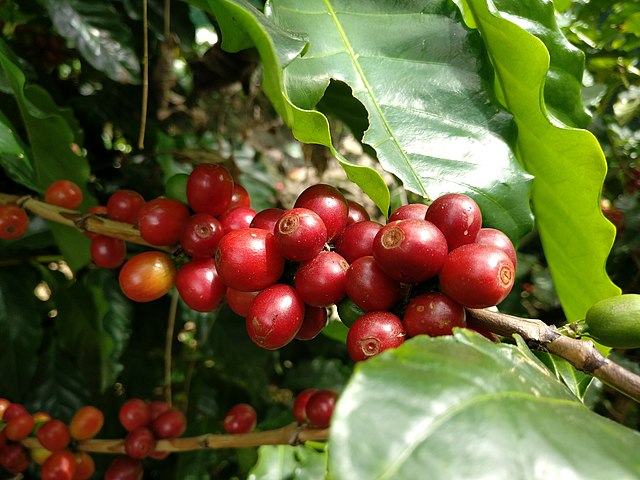Coffee:
What is it?, history, cultivation, nutritional value, uses, recipes, and more...
Coffee is a hot beverage consumed in the vast majority of countries around the world. Its name derives from a tree: the coffee plant, whose bean is used for making this infusion.
These beans are used for brewing the infusion by being roasted and mixed with hot water to create the beloved beverage that we all know and love.
Índice
What is Coffee?
Coffee is the seed of the coffee plant (coffea), which, when roasted and ground, becomes the highly stimulating beverage that we all know. It is one of the most traded commodities in the world and one of the three most consumed beverages globally (alongside water and tea).
The coffee tree, or coffea, is a shrub originating from tropical regions of the Coffea genus, part of the Rubiaceae family. It can grow to be between 4 and 6 meters in height, but it is often pruned to a shorter height to facilitate easier harvesting of the beans. It has persistent and opposite leaves, and its fruits, which are fleshy and turn red or purple when ripe, are known as coffee cherries. In this sense, coffee is a fruit with berries containing two cores, each of which has a coffee bean that is the plant’s seed. The seeds are approximately 1 centimeter in size and are surrounded by a semi-rigid transparent membrane called parchment, as well as a mucilage-rich mesocarp, which is a layer of sugary pulp. Removing this layer reveals the green coffee bean, surrounded by an adherent silver skin, corresponding to the seed’s tegument.
The coffee plant originates from the Kaffa region in Abyssinia, now modern-day Ethiopia, where it grows wild. It was later introduced to Arabia and spread throughout the world with the Turkish dominion over Anatolia. Nowadays, the plant is primarily cultivated in tropical and subtropical countries, where it thrives under certain shade conditions. Brazil accounts for a little over one-third of the world’s coffee production. The commercialization of coffee often contributes significantly to the export sectors of producing regions.
Coffee is considered one of the most socializing non-alcoholic beverages in the world, boasting an impressive 800 compounds that stimulate the taste buds.
Coffee is the second most traded commodity globally. According to the Fairtrade Foundation, over 125 million people worldwide depend on coffee every day, with around 25 million farms producing 80% of the world’s coffee.
In Peru, coffee is one of the most important crops, accounting for 9% of the gross domestic product. Approximately 224,000 farmers cultivate it, with the majority of production occurring in the Amazon region (between 800 and 2000 meters above sea level).
History of Coffee
The history of coffee’s origin begins in Ethiopia, likely in the Kaffa province. There’s a legend that tells of a young shepherd and poet named Kaldi in Ethiopia who observed the energizing effect on his goats after they consumed coffee cherries, and he tried it himself. Kaldi took the fruit to a nearby monastery, where the monks turned it into a beverage, using it as a stimulant to stay awake during nighttime religious services.
Another widely spread theory asserts that the ancestors of the Oromo people were the first to recognize the energizing effect of coffee by mixing ground coffee beans with fat, forming balls to use as rations on warrior expeditions.
There are no conclusive archaeological records that allow us to affirm coffee’s use or knowledge before the 15th century, and it’s speculated that its discovery might have been delayed due to the long and complex process required to bring out its virtues. However, what is clear is that the first mention of coffee use was written by Abd Al-Qadir al-Jaziri in the 1550s, who claimed to drink qahwa, the Arabic term for coffee, which means “invigorating.” In his manuscript, he narrates that coffee was brought from Ethiopia to Yemen around the mid-15th century, where Sufis used it to stay awake during their prayers.
More distinctly, it is known that slaves transported from what is now Sudan to Yemen and Arabia through the major port of the time, Mocha (which also became a term for a type of coffee and coffee bean), consumed the fleshy part of the coffee cherry. This leaves no doubt that coffee was already being cultivated in Yemen by the 15th century.
The Arabs had a strict policy of not exporting fertile coffee beans to prevent cultivation in other places. Although many tried to secretly take coffee plants or fertile beans, the Dutch were the first to successfully bring some to Holland in 1616, where they were cultivated in greenhouses.
Initially, Yemen’s authorities encouraged coffee consumption as its effects were considered preferable to “kat,” a shrub whose leaves and shoots were chewed as a stimulant. The first coffee-serving establishments, known as “kaveh kanes,” opened in Mecca. This type of business spread rapidly throughout the Arab world, becoming pleasant meeting places where people enjoyed singing, dancing, and music in a comfortable, luxurious setting, accessible to all for the price of a cup of coffee.
However, shortly afterward, these establishments became centers of political activity and were prohibited by authorities. It was believed that coffee consumption developed critical thinking, facilitating dangerous intellectual exchanges among consumers. In the following decades, coffee and its establishments were suppressed many times but kept reappearing. The ultimate solution came later: coffee and its establishments would be taxed.
The first to bring coffee to Europe were Venetian traders in 1615. At the time, Pope Clement VIII was advised to ban coffee due to it being perceived as a threat from infidels. However, after trying it, the Pope baptized the new beverage, declaring that leaving the pleasure of this drink exclusively to infidels would be a pity. Monks embraced coffee because it allowed them to stay awake for long periods and, they claimed, kept the spirit pure. During that period, two other well-known hot beverages also appeared in Europe: hot chocolate, brought by the Spanish from the Americas to Spain in 1528, and tea, first sold in Europe in 1610.
Initially, coffee was mainly sold by lemonade vendors, and it was believed to have medicinal qualities. The first coffeehouse in Europe opened in Venice in 1683, known as the famous Caffè Florian on St. Mark’s Square, which opened its doors in 1720 and continues to operate today.
By the mid-18th century, coffeehouses existed in all European cities, and in 1734, Johann Sebastian Bach composed his famous “Coffee Cantata,” in which a girl asks her father not to punish her by prohibiting coffee and states that her future husband should allow her to drink it.
In Russia, initial acceptance was difficult, and coffee was banned under penalties of torture and mutilation. Additionally, when the czarist police encountered someone with a nervous crisis, they attributed it to coffee.
The first record of coffee in America dates back to 1668, in North America. Shortly after that, coffeehouses opened in New York, Philadelphia, Boston, and other cities. Interestingly, in the U.S., coffee gained popularity and became the national drink after rebels threw the taxed tea into the sea during the Boston Tea Party of 1773, organized in a coffeehouse, the Green Dragon. Both the New York Stock Exchange and the Bank of New York began in coffeehouses, in what now belongs to the financial district of Wall Street.
Around 1720, coffee was first cultivated in the Americas by French naval officer Gabriel Mathieu de Clieu. He managed to conceal a coffee plant cutting that had been offered by the Dutch to King Louis XIV of France and was kept in royal greenhouses. After a series of adventures, he brought a cutting to the island of Martinique in the Caribbean, where the coffee plant grew, multiplied, and produced its first harvest in 1726. It’s recorded that by 1777, there were between 18 and 19 million coffee plants in Martinique. This established the model for a new commercial crop that could thrive in the New World.
However, it was the Dutch who spread the coffee plant in Central and South America, where it is now one of the main commercial crops on the continent. Coffee first reached the Dutch colony of Surinam in 1718, and coffee plantations were established in French Guiana and Pará, Brazil. In 1730, the British brought coffee to Jamaica, where the world’s most famous and expensive coffee, the Blue Mountain coffee, is grown today. In 1784, Capuchin missionaries brought the first coffee seeds to Venezuela from Brazil, while coffee arrived in Colombia from the French Antilles.
Colombia and Peru have a significant number of high-quality organic coffee plantations that are gaining global recognition. For several decades in the 19th and 20th centuries, Brazil was the largest coffee producer in the trade, until a policy of maintaining high prices created business opportunities for other producers like Colombia, Costa Rica, El Salvador, Guatemala, Indonesia, Mexico, Peru, and Venezuela.
Today, you can find coffee on any street in the United States (the largest consumers worldwide) and much of the rest of the world. Coffee is one of the most valuable primary products. Its cultivation, processing, trade, transport, and marketing provide employment to millions of people globally and are of crucial importance to the economies and politics of many developing countries.
By the mid-18th century, coffee was already being produced in Chanchamayo, Moyobamba, San Ignacio, Jaén, Huánuco, and Cusco for local consumption and for export to Germany, Chile, and Great Britain. The first café in Lima opened in 1771 on Santo Domingo Street by Francisco Serio.
Peruvian varieties include Good Hard Bean (Central Jungle), Hard Bean (Northeastern Jungle), and Medium Hard Bean (Southeastern). Among them, the first fetches the best prices.

Common name of coffee
| Spanish | Café, Cafeto, Café de Arabia, Café de Moka, Cafeto borbón, Cafeto común de Colombia, Cafeto enano, Cafeto San Lorenzo, Cafeto San Ramón |
| Quechua | kajwi, cafi, ch’umpi |
| Aymara | ch’umphi |
| English | Coffee |
| Italian | Caffe |
| Dutch | Koffie |
| Turkish | Kahveh |
| French | Café |
Scientific name of coffee
Coffea
Taxonomy of coffee
| Kingdom | Plantae |
| Division | Magnoliophyta |
| Class | Magnoliopsida |
| Order | Gentianales |
| Family | Rubiaceae |
| Subfamily | Ixoroideae |
| Tribu | Coffeeae |
| Gender | Coffea |
| Species | arabica, canephora, liberica, deweri, entre otras |
Synonymy of coffee
- Cafe Adans., Fam. Pl., 2: 500, 1763
- Cafea Adans., Fam. Pl., 2: 145, 1763
- Hexepta Raf., Sylva Tellur.: 164, 1838
- Leiochilus Hook.f. in G.Bentham & J.D.Hooker, Gen. Pl., 2: 116, 1873
- Pleurocoffea Baill., Bull. Mens. Soc. Linn. Paris, 1: 270, 1880
- Solenixora Baill., Bull. Mens. Soc. Linn. Paris, 1: 242, 1880
- Buseria T.Durand, Index Gen. Phan.: 501, 1888
- Paolia Chiov., Result. Sci. Miss. Stefan.-Paoli Somal. Ital., 1: 93, 1916
- Psilanthopsis A.Chev., Rev. Bot. Appl. Agric. Trop.. 19: 403, 1939
- Nescidia A.Rich. ex DC., Prodr., 4: 477, 1830
Etymology of coffee
According to the RAE (Royal Spanish Academy), the word “café” derives from the Italian word, which in turn comes from the Ottoman Turkish “kahve,” which further comes from the classical Arabic “qahwah.” The term “qahwah” could be the Arabic term for the historical Ethiopian region of Kaffa or Caffa, and it is a term used to refer to wine.
Coffee Habitat
- Habitat
A young coffee plant requires 3 to 4 years before it starts producing coffee beans. The plant reaches maturity at around 6 to 8 years of age and can live for many decades, but it is only suitable for coffee production until around 25 to 30 years.
From the moment of flowering, it takes between 7 to 9 months before the coffee seed can be harvested. This time frame varies depending on the climate and altitude of the area.
During harvesting, coffee pickers will only collect ripe fruits known as coffee cherries. Subsequently, they remove the fruit, leaving only the coffee bean. The process for this can be dry, wet, or semi-dry.
Afterwards, a classification is done to separate damaged or defective beans from the rest of the production. They then move on to the polishing stage where the skin is removed, improving the appearance of the beans.
Finally, they are stored (unroasted) and require a moisture level of 12% to prevent acquiring an unpleasant odor or developing fungi.
Currently, two species of coffee plants, Coffea arabica and C. canephora (Robusta), supply the coffee consumption for almost the entire world. Arabica is considered smoother, more aromatic, and fuller-bodied than Robusta, the primary variety of C. canephora.
Optimal coffee production is directly related to quality at every stage of its development. Like any crop, coffee has specific agroclimatic requirements that must be considered to ensure satisfactory yields:
PARAMETERS OF ADAPTABILITY AND RANGE OF ADAPTATION
Altitudinal Range: 500-1700 meters above sea level
Temperature (Optimal): 21 °C
Temperature Range (Maximum and Minimum): 17°C - 23 °C
Relative Humidity: 85%
Soil pH: 5 - 5.5
Soil Texture: F, Fa
Photoperiod: 5-12 hours/day (with shade)
Optimal Precipitation: 1000-3000 mm annually
Topography: Less than 10%
The top 5 coffee-producing countries in the world are Brazil, Vietnam, Colombia, Indonesia, and Ethiopia (US Department of Agriculture, 2020).
Peru possesses optimal conditions for the production of specialty coffees due to its various ecological zones with suitable climates for cultivation. We have Arabica coffee types such as Típica, Caturra, Borbón, and Pache, produced under shade and environmentally friendly practices.
Our country actively participates in the global organic coffee market. It is one of the main producers along with Mexico and Papua New Guinea. Peru exports 10% of the world's organic coffee.
Coffee represents one of the main export products in the country, with coffee exports reaching $648.2 million in 2020. We have consistently remained among the top 10 coffee-exporting countries (7th) in the world, exporting 4.3 million bags (Minagri, 2020).
Our coffee is distributed worldwide, especially to the United States, Europe, and various Asian countries. Initially purchased as a substitute for Colombian coffee, we have gained a prominent place in consumer demand due to our excellent quality. Consumers appreciate the mild, slightly sweet taste, good body, and delicate aroma of Peruvian coffee, which has earned numerous awards in quality competitions and barista championships around the world.
Peruvian coffee is cultivated in 350,000 hectares of coffee plantations in 210 rural districts located in 10 departments on the eastern slope of the Andes. Amazonas, San Martín, and Chanchamayo are the main coffee-growing regions. While Chanchamayo, the traditional coffee region of origin in Peru, still accounts for 16% of total production, Amazonas and San Martín together represent 47% of national production.
Peru predominantly produces Arabica coffee, of which over 70% is the Typica variety, followed by Caturra (20%) and others (10%). The average plant density on farms is around 2,000 coffee trees per hectare, although this number can vary significantly depending on the cultivation areas.
Geographical Distribution of Coffee

San Martín, Junín, Cajamarca, Amazonas, Cuzco
Seasonal Availability of Coffee
- Higher production levels in Peru: March, April, May, June
Coffee Varieties
There are two major genetic species or types of coffee: Arabica Coffee (Coffea Arabica) and Robusta Coffee (Coffea Canephora). Based on this classification and the botanical characteristics of the plant, there are multiple varieties and subvarieties.
-
On a Global Scale
Arabica Coffee (Coffea Arabica)
-
In Places Like
Tarrazú in Costa Rica. Huehuetenango in Guatemala. Harrar in Ethiopia. Yirgacheffe in Ethiopia. Aricha in Ethiopia. Sidamo in Ethiopia. Hawaiian Kona. Jamaican Blue Mountain Coffee. Java from the island of Java, Indonesia. Kenya AA from Kenya. Mandheling and Lintong from Sumatra. Toraja Kalossi from Sulawesi. Mocha. Peaberry from Tanzania. Kopi Luwak (or civet coffee). Sierra Nevada de Santa Marta, Colombia. -Robusta Coffee (Coffea Canephora) In Peru [All belong to the Arabica variety] Typica Caturra Catimor Pache Bourbon
Nutritional Value of Coffee
The main compound in coffee, caffeine, is a psychoactive drug with strong effects on our nervous system that have been studied by numerous scientists. A revealing study published in July 2017 showed that consuming three cups of coffee per day reduces the risk of death.
Coffee is not only a powerful stimulant (a characteristic with both pros and cons), but it also has a vasodilator effect and seems to have a preventive effect against diseases like diabetes and certain types of cancer. Among the main benefits it offers are:
- Increases concentration and attention levels
- Improves physical performance
- Promotes fat burning Combats depression
- Produces satiety and provides a low-calorie intake
- Enhances the effects of painkillers
- Has detoxifying and diuretic effects on the skin Acts as a natural anti-cellulite treatment
- Reduces under-eye circles Is anticancer
- Prevents type II diabetes and Alzheimer’s disease
- Promotes digestion
Health Benefits of Coffee
Coffee is considered a natural energizer that can help increase your physical and mental performance. Learn about its nutritional value.
Contraindications or Side Effects
While coffee has multiple beneficial effects on health, it also has contraindications to consider. Coffee can cause digestive problems, including nausea, vomiting, and diarrhea. Additionally, coffee triggers a laxative effect due to the release of gastrin, a hormone that stimulates movement in the digestive tract.
Caffeine can also worsen the symptoms of gastroesophageal reflux disease (GERD), characterized by heartburn, nausea, and belching. Furthermore, caffeine can negatively affect muscles, hormones, neurotransmitter function, and nerve signaling. It could alter mood, increase anxiety, and cause insomnia. Caffeine can affect muscles, hormones, neurotransmitter function, and nerve signaling in individuals with existing health conditions like heart problems or diabetes.
Another disadvantage of consuming coffee is that excessive intake can quickly lead to dehydration, and coffee abuse can harm heart rhythm.
| 10 Porciones por Kilogramo | |
| Tamaño de porción | 100g |
| Cantidad por porción Calorías |
203 |
| Cantidad por 100g | |
| Energía | 849 kJ |
| Grasa Total | 10.8 g |
| Sodio | ● |
| Carbohidratos totales | 68.2 g |
| Carbohidratos disponibles | ● |
| Fibra Dietaria | ● |
| Proteínas | 11.7 g |
| Calcio | 120 mg |
| Fósforo | 178 mg |
| Zinc | ● |
| Hierro | 2.90 mg |
| Potasio | ● |
| Agua | 6.3 g |
| Cenizas | 3.0 g |
| Vitamina A | 3 μg |
| Tiamina (B1) | 0.22 mg |
| Riboflavina (B2) | 0.06 mg |
| Niacina (B3) | 1.30 mg |
| Vitamina C | ● |
| Acido Fólico (B9) | ● |
| β-Caroteno | ● |
| Fuente: Tablas peruanas de composición de alimentos – Centro Nacional de Alimentación y Nutrición – Ministerio de Salud – Perú | |
Derived Coffee Products and Consumption Forms
Uses of Coffee
After water, coffee is the most consumed beverage in the world, and yet, it can be enjoyed not only as a hot infusion but also has multiple alternative uses that harness its fantastic qualities in various ways and across different industries.
- Culinary
- Industrial
- Ritual
Culinary Use of Coffee
Among the flavors of coffee are: sweet, fruity, acidic, pronounced, characteristic of coffee, and bold. These flavors are not only enjoyed in the well-known infusion, but coffee is also an ideal ingredient in cooking. Coffee enhances flavors, so it can be used in both sweet and savory recipes, although it is more commonly used in desserts and baking.
There are sweets made with coffee such as custards, flans, cakes, pastries, fillings, ice creams, sorbets, liqueurs, and more.
For savory dishes, concentrated coffee is often used in very small amounts. For example, it can be used to darken and add certain flavor nuances to a meat sauce.
Medicinal Use
Caffeine, the primary active component of coffee, has diuretic and stimulating properties on the nervous system, leading to heightened alertness and concentration, which prevents sleepiness.
According to traditional Chinese medicine, drinking coffee can have therapeutic uses if consumed in small doses (one to three cups daily). It is recommended for fatigue and exhaustion, headaches, dizziness, chronic bronchitis, pulmonary emphysema, slow heart rate accompanied by a sensation of cold, digestive disorders, and excessive alcohol consumption.
Furthermore, coffee helps stimulate the elimination of fluids from the body, making it useful in the treatment of conditions like cystitis, nephritis, or urinary tract infections.
Every day, more benefits of this bean are being acknowledged, including preventing degenerative diseases, slowing down aging, controlling diabetes, combating asthma, preventing liver cirrhosis, managing depression, reducing headaches, benefiting the mind, and preventing colorectal cancer.
Now, it's not only coffee beans that have important healing properties but also the coffee plant itself, which can be applied to wounds for infection issues, eye problems like conjunctivitis, or even external tumors, where it might offer some improvement.
Industrial Use of Coffee
Coffee is used in a wide variety of products, ranging from culinary to cosmetic and many others. Due to its aromatic characteristics, coffee is often used as an air freshener in enclosed spaces. As an organic residue rich in fibers, organic compounds, and elements such as sodium, potassium, magnesium, phosphorus, and iron, coffee is also used in the creation of plant fertilizers. Additionally, thanks to its strong aroma, it's employed as an insect repellent, and the acidic and abrasive nature of coffee grounds makes them a useful ingredient in cleaning products.
Furthermore, coffee is increasingly valued in the cosmetic industry where, thanks to its numerous properties, it is used as an exfoliant, hair dye, face masks, shampoo, and more.
Ritual Use of Coffee
In Ethiopia, the birthplace of coffee, there is a ritual that is enjoyed both in Ethiopian homes and in all the tourist hotels in the area.
This ceremony is conducted with solemnity during all major festivities to honor guests and friends, as well as during weddings or family celebrations.
In the ceremony, the woman of the house is responsible for all the preparation and the accompanying ritual. The house is decorated in advance and the floor is carpeted with freshly cut herbs.
The ritual begins with the roasting of coffee beans in an iron pan over a charcoal or wood brazier. The beans are constantly stirred until they take on their characteristic dark color and emit the oils responsible for their magnificent aroma.
Once the beans are roasted, the pan is passed among the guests so that they can appreciate the subtle aromas released. Next, the beans are ground into a fine powder using a mortar and pestle or an electric grinder, and water is heated in the traditional black clay coffee pot, the yebena.
Slowly, the ground coffee is added to the water, and it's left to boil. Finally, it's allowed to settle until the grounds settle at the bottom, and then the precious brew is served.
- jolgoriocafe.com
- es.glosbe.com
- elespanol.com
- caracteristicas.co
- worldagroforestry.org
- inia.gob.pe
- ico.org
- cafemalist.com
- agraria.pe
- sommelierdecafe.com
- es.wikipedia.org
- elcomercio.pe
- agrotendencia.tv
- es.wikipedia.org
- juntadelcafe.org.pe
- vegaffinity.com
- elconfidencial.com
- eldiario.es
- diariocorreo.pe
- quecafe.info
- eltiempo.com
- elautenticocafe.es



